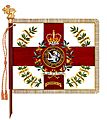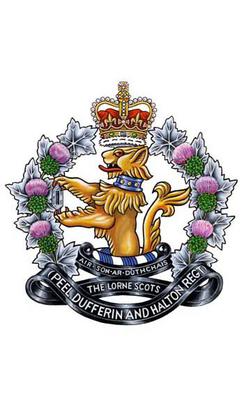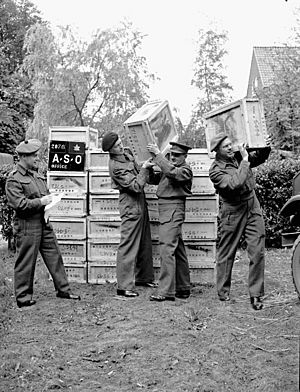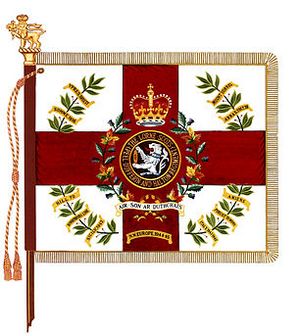Lorne Scots (Peel, Dufferin and Halton Regiment) facts for kids
Quick facts for kids The Lorne Scots (Peel, Dufferin and Halton Regiment) |
|
|---|---|
| Active | 14 September 1866 – present |
| Country | Canada |
| Branch | Canadian Army |
| Type | Line infantry |
| Role | Light infantry |
| Size | One battalion |
| Part of | 32 Canadian Brigade Group |
| Garrison/HQ |
|
| Motto(s) | Air son ar duthchais (Scottish Gaelic for 'for our heritage') |
| March |
|
| Mascot(s) | Wild boar |
| Anniversaries | September 14, regimental birthday |
| Engagements |
|
| Battle honours | See #Battle honours |
| Commanders | |
| Current commander |
LCol Adam MacInnis, CD |
| Colonel-in-Chief | Prince Edward, Duke of Kent |
| Insignia | |
| Tartan | Ancient Ordinary Campbell |
| Facings | White |
| Hackle | Primerose |
| Colours | Blue, grey and green |
The Lorne Scots (Peel, Dufferin and Halton Regiment) is a special part of the Canadian Army. It's a Primary Reserve infantry regiment, which means its soldiers are part-time but ready to serve when needed. This regiment is a key part of the 4th Canadian Division's 32 Canadian Brigade Group.
Contents
How the Lorne Scots are Organized
The Lorne Scots regiment has different groups, called sub-units, located in various towns:
- The main office, called Regimental Headquarters (RHQ), is in Brampton, Ontario.
- The Dufferin Company (which handles administration) is in Brampton and Georgetown, Ontario.
- The Campbell Company has groups in Brampton, Oakville, and Georgetown, Ontario.
- The Pipes and Drums band, which is part of Dufferin Company, is based in Georgetown.
The current leader of the regiment is Lieutenant-Colonel Adam MacInnis. The top non-commissioned officer is Chief Warrant Officer Matthew Colbeck.
The Lorne Scots played a big role in World War II, sending many soldiers to protect headquarters. Since 1945, many of their soldiers have also gone on overseas missions. They have helped with peacekeeping in places like the Middle East, Golan Heights, Namibia, Cambodia, Cyprus, the Former Yugoslavia, and Afghanistan.
Regimental History
How the Regiment Started
The Lorne Scots (Peel, Dufferin and Halton Regiment) began in Brampton, Canada West, on September 14, 1866. It was first known as the 36th "Peel Battalion of Infantry." Over the years, its name changed several times. On December 15, 1936, it joined with another group called the Lorne Rifles (Scottish). This is when it became The Lorne Scots (Peel, Dufferin and Halton Regiment) we know today.
The Lorne Rifles (Scottish) started in Milton, Canada West, on September 28, 1866. It was first called the 20th "Halton Battalion of Infantry." This group also changed its name many times before joining with the Peel and Dufferin Regiment in 1936.
What "Perpetuate" Means
The Lorne Scots "perpetuate" several older battalions from the Canadian Expeditionary Force (CEF) and other regiments. This means they carry on the history and traditions of these past units. It's like keeping their memory alive and honoring their service. They also carry special awards, called battle honours, from the War of 1812.
Regimental Badges
Cap Badge
The cap badge is a special symbol worn on the uniform hat. It shows a silver lion wearing a blue collar with gold circles, holding a gold shuttle. Above the lion is the Royal Crown. All of this is surrounded by maple leaves and thistles, with scrolls that say "AIR SON AR DUTHCHAIS" (which means "for our heritage") and "THE LORNE SCOTS (PEEL, DUFFERIN AND HALTON REGT)".
The design of the cap badge was updated in 2016 to look more like the image on the regiment's flag. The lion, which used to be gold, is now silver, and the shuttle, once silver, is now gold.
Collar Badge
The Lorne Rifles (Scottish) were given special permission in 1931 to wear the crest of the Duke of Argyll, who is the leader of the Clan Campbell in Scotland. This crest is a "Boar's head." Soldiers wear this boar's head on their uniform collars.
Important Moments in History
On September 14, 1866, the 36th Peel Battalion was created. Soon after, on September 28, the 20th Halton Battalion of Infantry was formed. These were some of Canada's first militia regiments. About 70 years later, these two groups would combine to form the Lorne Scots.
The first Scottish connection happened in 1879 when the Halton Rifles were reviewed by the Marquis of Lorne. In 1881, they were allowed to change their name to the 20th Halton Battalion Lorne Rifles. They also started wearing tartan pants and a special hat called a Glengarry, and they formed a Pipe Band.
First World War (1914-1918)
During the First World War, many soldiers from the Peel and Halton areas joined different battalions of the Canadian Expeditionary Force (CEF). These battalions often provided new soldiers to larger Canadian units fighting in Europe.
For example, the 37th Battalion, 74th Battalion, 76th Battalion, 126th Battalion, 164th Battalion, and 234th Battalion were all formed with local recruits. Many of these units traveled to Great Britain to help reinforce Canadian troops already fighting. While some hoped to fight as complete units, they were often broken up to send soldiers where they were most needed due to heavy casualties.
The 74th Battalion, for instance, was raised mainly from Peel county. Its flag was later placed in Christ Church, Brampton, in 1924. The 126th Battalion's regimental march, "John Peel," was later adopted by the Peel and Dufferin Regiment. The 164th Battalion received its flags from the ladies of Halton and Dufferin counties.
Between the World Wars (1918-1939)
After the First World War, the local regiments needed to be rebuilt. The Peel Regiment was reorganized. In 1923, it became The Peel and Dufferin Regiment, including soldiers from both counties. They received permission to use part of Sir Robert Peel's family crest as their badge, which featured a lion and a shuttle.
In 1931, the Halton Rifles became the Lorne Rifles (Scottish). They were allowed to use the Duke of Argyll's personal crest (the boar's head) and his family tartan. Finally, on December 15, 1936, the Lorne Rifles and the Peel and Dufferin Regiment joined together to create the current regiment, The Lorne Scots (Peel, Dufferin and Halton Regiment).
Second World War (1939-1945)
When World War II began in 1939, the Lorne Scots quickly formed the No. 1 Infantry Base Depot, CASF. This unit was responsible for training soldiers, including cooks, and managing Canadian troops arriving in Britain. They were stationed in places like Brampton, Toronto, and later Liverpool, England.
The soldiers of the Depot faced dangers even in Britain. During heavy German air raids on Liverpool, they helped civil defense workers. They rescued injured people, put out fires, drove trucks, and guided traffic, showing great bravery. Captain D.C. Heggie, the medical officer, was even awarded the George Medal for his courage in helping wounded civilians during a bombing raid.
The regiment also formed the 1st Battalion, The Lorne Scots (Peel, Dufferin and Halton Regiment), CASF in 1941. This battalion provided soldiers for various "Defence and Employment" roles across the Canadian Army.
Dieppe Raid
During the Dieppe Raid in August 1942, a small group from the Lorne Scots, No. 6 Defence Platoon, landed on the beaches. They faced intense enemy fire. Many were reported missing, wounded, or helped rescue others from the water. Their bravery during this difficult operation was notable.
Protecting Army Headquarters
In 1942, as the Canadian military grew in Britain, the Headquarters First Canadian Army, Defence Company (Lorne Scots) was formed. Their job was to protect the Army Headquarters. They trained hard, guarded important locations, and provided honor guards for important visitors.
Fighting in Italy
Canadian troops, including some from the Lorne Scots, joined the invasion of Sicily in July 1943. They then moved into mainland Italy. The Lorne Scots Defence Company took over a defensive position near Ortona in February 1944. They went on dangerous patrols to gather information about the enemy. One corporal, Tost, and two volunteers went on a fighting patrol to try and capture a prisoner, facing constant enemy flares and fire.
Later, in 1945, with Italy secured, Canadian forces, including the Lorne Scots, secretly moved to north-western Europe to continue the fight.
Defending Canada
During World War II, there were fears of invasion on Canada's Pacific coast due to Japanese activity. The Lorne Scots also formed No. 6 Defence and Employment Platoon for the 6th Canadian Division to help defend Canada. They trained in places like Brantford and Camp Niagara, with some soldiers eventually moving to British Columbia. By late 1944, as the need for coastal defense lessened, this platoon was disbanded.
After the Wars
Since World War II, the Lorne Scots have continued to be an active and important regiment. In 1955, they had the most soldiers attend summer camp of any infantry regiment in Canada. They are also known for their excellent marksmanship, winning many shooting competitions.
In the 1960s, their allied regiment in England, the Lancashire Fusiliers, gave the Lorne Scots their special "primrose hackle" (a feather plume) to keep. Lorne Scots infantry soldiers proudly wear this on their hats today.
The regiment's first-ever Colonel-in-Chief, Field Marshal Prince Edward, Duke of Kent, has visited the regiment several times. He presented them with new regimental flags in 1991 to celebrate their 125th birthday.
Lorne Scots soldiers have also served in many United Nations peacekeeping missions around the world. These include places like the Golan Heights, Namibia, Cambodia, Cyprus, and the Former Yugoslavia. They also helped with cleanup after the 1998 Ice Storm in eastern Ontario and participated in Operation Nanook in the Canadian Arctic. In 2010, soldiers from the regiment helped with security for the G20 Toronto Leaders Summit.
More recently, the regiment has sent soldiers to Nunavut for training exercises and participated in international exercises like Golden Coyote in South Dakota. They have also contributed soldiers to the International military intervention against ISIL and training missions in Jordan and Ukraine. In 2020, many soldiers helped with Operation Laser, Canada's response to the COVID-19 pandemic.
War in Afghanistan (2001-2014)
The Lorne Scots sent a significant number of soldiers to Afghanistan between 2002 and 2014. More than 20% of their authorized strength served in various task forces there. Two members of the regiment were wounded during their service and received the Sacrifice Medal.
Regimental Pipes and Drums
The Lorne Scots has its own military pipe band, known as the Regimental Pipes and Drums. This band started in 1881 and is one of the oldest pipe bands in Canada. They provide musical support to the regiment and are based in Georgetown, Ontario.
The Pipes and Drums of the Lorne Scots were the first Primary Reserve pipe band to perform at the famous Edinburgh Military Tattoo in Scotland, performing in 1960 and again in 1970. They have also played for important figures like Queen Elizabeth II and Canadian leaders. The band has toured the United Kingdom and the United States, even performing at the Tower of London.
Commanding Officers
Here is a list of the leaders, called Commanding Officers, of the Lorne Scots regiment:
- LCol Godfrey Fitzgerald, 1936–39
- LCol Louis Keene, 1939
- Col Reginald Conover, 1939–42
- LCol Leonard Bertram, 1942–46
- LCol Newton Powell, 1946
- LCol Charles Sharpe, 1946–47
- LCol Herbert Chisholm, 1947–49
- LCol John R. Barber, 1949–54
- LCol Samuel Charters, 1954–57
- LCol Arthur Kemp, 1957–61
- LCol Edward Conover, 1961–65
- LCol Robert Hardie, 1965–68
- LCol Earl Lince, 1968–71
- LCol Donald Egan, 1971–74
- LCol Frank Ching, 1974–78
- LCol Lowell Breckon, 1978–79
- LCol Larry Smith, 1979–81
- LCol Robin Hesler, 1981–85
- LCol Jerry Derochie, 1985–88
- LCol John Rodaway, 1988–92
- LCol Richard Irvine, 1992–97
- LCol Douglas Johnson, 1997–2000
- LCol William Adcock, 2000–03
- LCol Ross Welch, 2003–06
- LCol Timothy Orange, 2006–09
- LCol Andre. M. Phelps, 2009–2012
- LCol Duane E Hickson, 2012–2016
- LCol Tom Ruggle, 2016-2020
- LCol Robert L Fraser, 2020–23
- LCol Adam MacInnis, 2023–Present
Regimental Museum
| Location | The Armoury, 48 John Street, Brampton, ON L6W 2H1 Canada |
|---|---|
| Type | Regimental Museum |
The Lorne Scots Regimental Museum is a special place that keeps important historical items for future generations. It shows off artifacts that tell the stories of the regiment and the Canadian Forces. You can see uniforms, weapons, musical instruments, maps, medals, and old photographs. The museum is located behind the armory in Brampton, Ontario and is open on certain days for everyone to visit.
Battle Honours
Battle honours are special awards given to regiments for their bravery and success in major battles or campaigns. The ones in bold type are proudly displayed on the regiment's flag. The newest flags, presented in October 2023, include honours from the War of 1812 and Afghanistan.
War of 1812
First World War
- YPRES, 1915, '17
- FESTUBERT, 1915
- MOUNT SORREL
- SOMME, 1916
- ARRAS, 1917, '18
- HILL 70
- AMIENS
- HINDENBURG LINE
- PURSUIT TO MONS
Second World War
War in Afghanistan
See also






